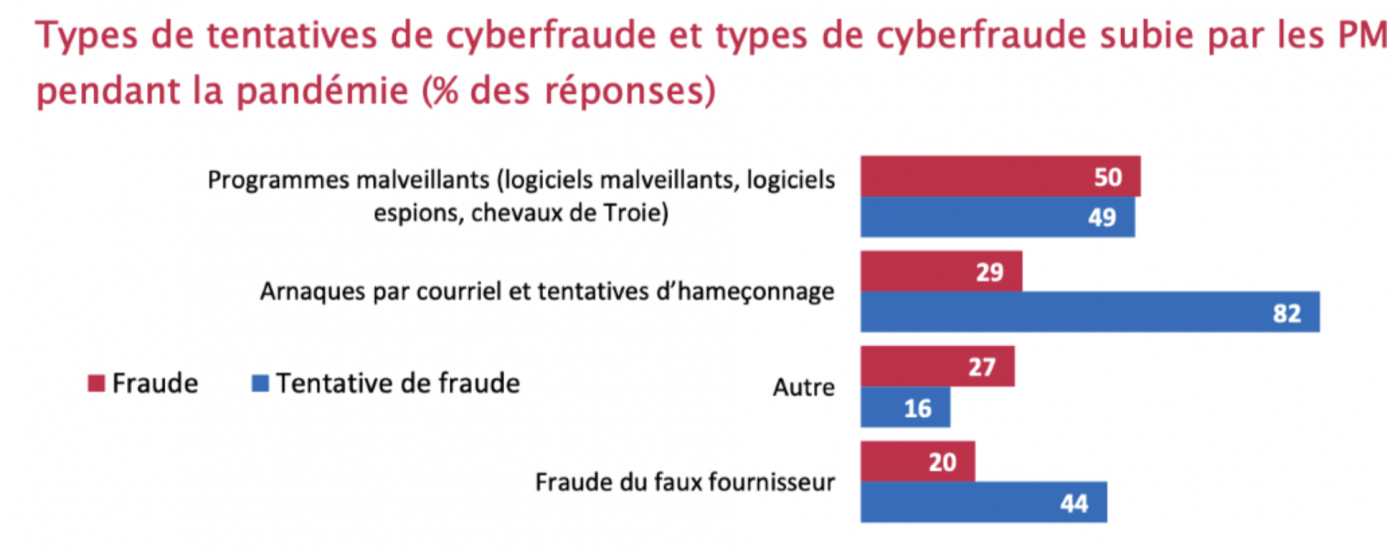Have you ever been the victim of a cyberattack? All businesses are at one time or another at risk of computer fraud. The stakes are high. Some of these attacks can even be fatal.
What are the most common types of computer fraud or cyberattacks? Read on. We will define the 3 main ones.
What is cybercrime against businesses?
Cybercrime is an activity carried out by criminal organizations which targets to compromise the computer systems of our companies via the Internet. The goal is in most cases the theft of confidential or critical data from our operations for financial purposes.
What is phishing?
Also known as “phishing”, this type of fraud occurs when a business has been attacked through fraudulent communications. For example, an employee may accidentally open a fraudulent link in an email that directs them to a bogus website. From that point on, scammers have remote access to the employee’s computer in order to retrieve personal information such as usernames and passwords.
What can be done to reduce the risk of phishing?
To counter phishing, SMBs provide training to their employees to make them aware of the danger. A To this, they obtain a specific cybercrime insurance policy and finally they hire experts to strengthen their IT and to be accompanied in the event of an incident.
What is a malware attack?
This technique refers to any program that is designed to break into and infect computers and computer networks through a vulnerability. Malware comes in many forms such as spyware, ransomware, and viruses.
Hackers can block access to company networks and render company systems unusable, or hack into a database in order to steal passwords, credit card numbers and data. ‘other confidential information. This compromises the security of all records for both internal employees and clients of the company.
What can be done to reduce the risk of malware?
The first step is to be vigilant. For example, beware of emails that ask us to provide information such as passwords.
A professional IT solution should be in place to protect your computer and network. Antivirus software can detect malware and recognize potential threats.
What is a man-in-the-middle attack (HDM)?
Also known as the man-in-the-middle attack or man-in-the-middle attack, this type of fraud occurs when a hacker breaks into a transaction between two people with the aim of to go and steal their personal information. These can be introduced through an unsecured WiFi network or through malware.
What can be done to reduce the risks of the middle man?
It is advisable to install encryption software that allows the encryption of communications between devices passing through unsecured networks such as the Internet.
If your employees must use public networks, L implementing firewall technologies reduces the risk to your network. It is also important to keep all your security software up to date, as well as all other applications and operating systems on your computers. These updates often target the fixing of known security vulnerabilities.
What is an employee cyberattack?
Unfortunately, a threat of fraud can arise internally, whether intentional or unintentional. For example, a malicious employee may be able to sell the personal data of company customers to another company for a fee. An error can also be involved. For example, an employee may post customer information online by accidentally attaching a confidential file via email.
How to reduce the risk of an employee’s cyberattacks?
It all starts with having a privacy policy in place and clearly detailing the company’s security processes.
It can be difficult to prevent ill-intentioned employees, but we can always limit who can access the confidential data of our customers and employees. Technologies also exist to detect the sending by email of data marked confidential and to record the identity of the members of your personnel requesting its export.
Final thoughts
Computer fraud has become a source of concern not just for large companies, but also for our SMBs. With e-commerce growing rapidly and teleworking forced by the pandemic, the risk of being affected is multiplied and for SMBs the risk is proportionately greater.
It is certainly important to react quickly when you are the victim of a computer attack or fraud, but to do that you have to understand our risk and be prepared. The basic practices that we have presented in this article are all recommended, but from these we encourage you to establish as soon as possible a relationship with a group of cybersecurity experts like B2B Cyber Secure. This relationship will bring the knowledge you need to quickly understand and reduce risk to your business.


